engine FORD FIESTA 2007 Workshop Manual
[x] Cancel search | Manufacturer: FORD, Model Year: 2007, Model line: FIESTA, Model: FORD FIESTA 2007Pages: 1226, PDF Size: 61.26 MB
Page 3 of 1226
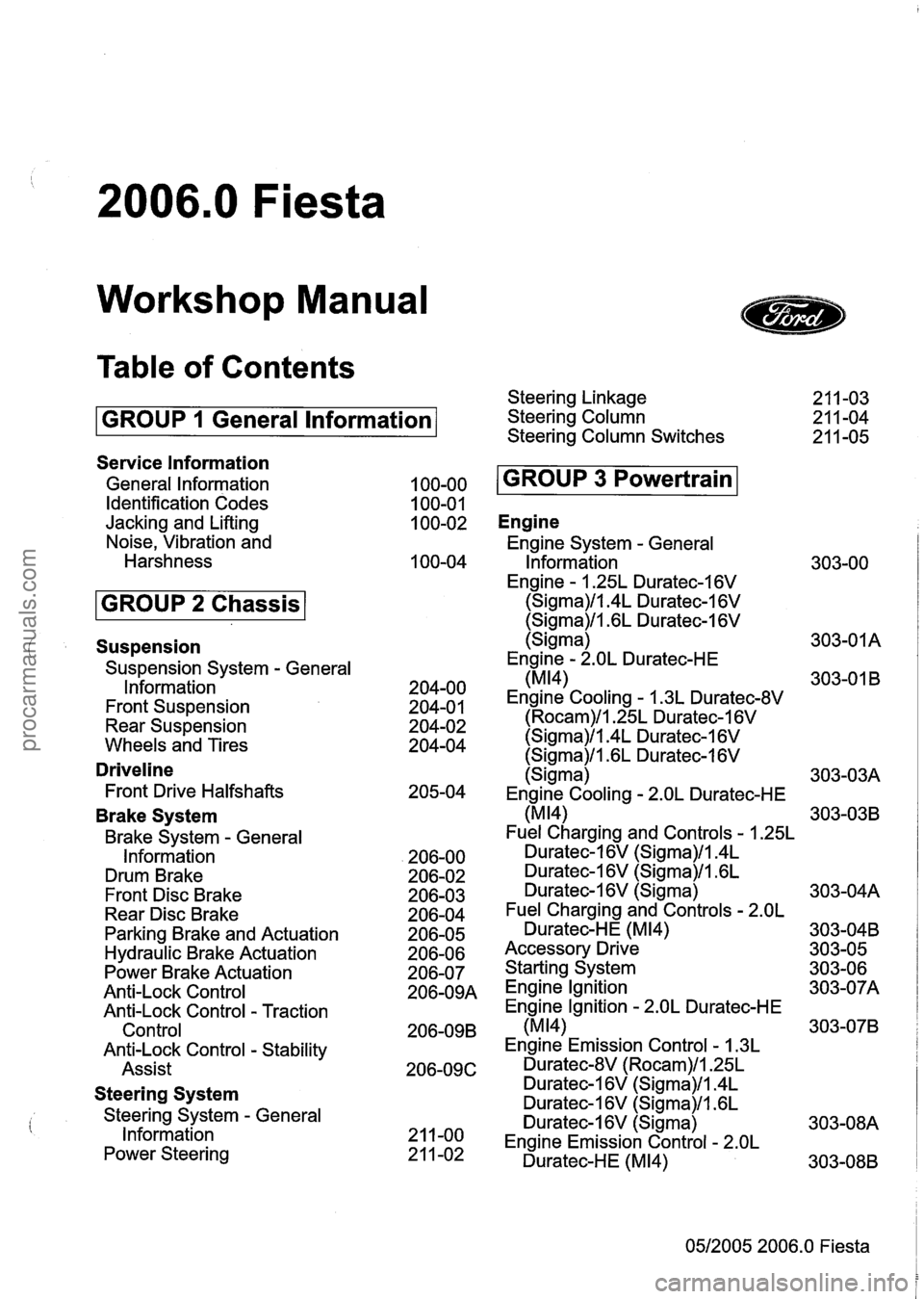
2006.0 Fiesta
Workshop Manual
Table of Contents
GROUP 1 General lnformation
Service lnformation
General lnformation
Identification Codes
Jacking and Lifting
Noise, Vibration and
Harshness
Suspension
Suspension System - General
lnformation
Front Suspension
Rear Suspension
Wheels and Tires
Driveline
Front Drive Halfshafts
Brake System
Brake System - General
Information
Drum Brake
Front Disc Brake
Rear Disc Brake
Parking Brake and Actuation
Hydraulic Brake Actuation
Power Brake Actuation
Anti-Lock Control
Anti-Lock Control
- Traction
Control
Anti-Lock Control
- Stability
Assist
Steering System
Steering System - General
lnformation
Power Steering Steering Linkage
Steering Column
Steering Column Switches
Engine
Engine System - General
lnformation
Engine
- 1.25L Duratec-1 6V
(Sigma)/l.4L Duratec-1 6V
(Sigma)/l.GL Duratec-I 6V
(Sigma)
Engine
- 2.OL Duratec-HE
(MI41
Engine Cooling - 1.3L Duratec-8V
(Rocam)/l.25L Duratec-1 6V
(Sigma)/l.4L Duratec-1 6V
(Sigma)/l .6L Duratec-1 6V
(Sigma)
Engine Cooling
- 2.OL Duratec-HE
(MI41
Fuel Charging and Controls - 1.25L
Duratec-1 6V (Sigma)/l.4L
Duratec-16V (Sigma)/l.GL
Duratec-1 6V (Sigma)
Fuel Charging and Controls
- 2.OL
Duratec-HE (M14)
Accessory Drive
Starting System
Engine lgnition
Engine Ignition
- 2.OL Duratec-HE
(M14)
Engine Emission Control - 1.3L
Duratec-8V (Rocam)/l.25L
Duratec-1 6V (Sigma)/l.4L
Duratec-1 6V (Sigma)/l .6L
Duratec-1
6V (Sigma)
Engine Emission Control
- 2.OL
Duratec-HE (M14)
05/2005 2006.0 Fiesta
procarmanuals.com
Page 4 of 1226
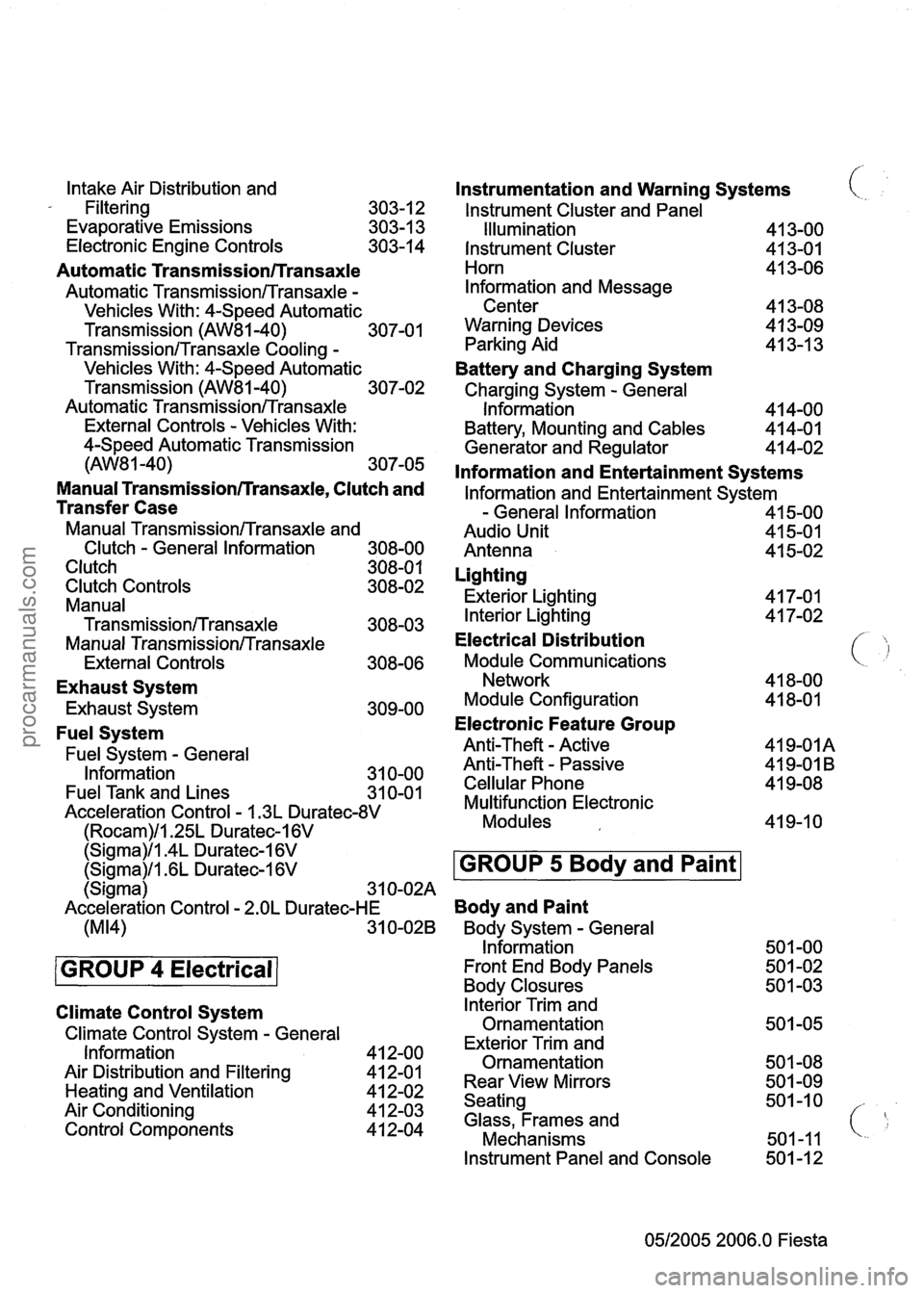
Intake Air Distribution and
- Filtering
303-1 2
Evaporative Emissions 303-1 3
Electronic Engine Controls 303-14
Automatic Transmission/Transaxle
Automatic TransmissionlTransaxle -
Vehicles With: 4-Speed Automatic
Transmission
(AW81-40) 307-01
TransmissionlTransaxle Cooling -
Vehicles With: 4-Speed Automatic
Transmission
(AW81-40) 307-02
Automatic
TransmissionlTransaxle
External Controls - Vehicles With:
4-Speed Automatic Transmission
(AW8 1 -40) 307-05
Manual Transmissionrrransaxle, Clutch and
Transfer Case
Manual TransmissionlTransaxle and
Clutch
- General Information 308-00
Clutch 308-0 1
Clutch Controls 308-02
Manual
Transmission/Transaxle 308-03
Manual TransmissionlTransaxle
External Controls 308-06
Exhaust System
Exhaust System 309-00
Fuel System
Fuel System - General
Information 31 0-00
Fuel Tank and Lines
31 0-01
Acceleration Control - I .3L Duratec-8V
(Rocam)ll.25L Duratec-I 6V
Instrumentation and Warning Systems
lnstrument Cluster and Panel
(
Illumination 41 3-00
Instrument Cluster
413-01
Horn 41 3-06
lnformation and Message
Center 41 3-08
Warning Devices
4 1 3-09
Parking Aid 41 3-1 3
Battery and Charging System
Charging System - General
Information 4 14-00
Battery, Mounting and Cables 414-01
Generator and Regulator 41 4-02
lnformation and Entertainment Systems
lnformation and Entertainment System
- General Information 41 5-00
Audio Unit 41 5-01
Antenna 41 5-02
Lighting
Exterior Lighting 41 7-01
Interior Lighting 4 1 7-02
Electrical Distribution
Module Communications ( 'j
Network 41 8-00
Module Configuration 41 8-01
Electronic Feature Group
Anti-Theft - Active 419-01A
Anti-Theft
- Passive 41 9-01 B
Cellular Phone 41 9-08
Multifunction Electronic
Modules 41 9-1 0
Climate Control System
Climate Control System - General
Information
Air Distribution and Filtering
Heating and Ventilation
Air Conditioning
Control Components
(Sigma)ll.4L Duratec-I 6V
lnterior Trim and
Ornamentation
Exterior Trim and
Ornamentation
Rear View Mirrors
Seating
Glass, Frames and
Mechanisms
(Sigma)/l .6L Duratec-1 6V
Instrument Panel and Console 501 -1 2
0512005 2006.0 Fiesta
GROUP 5 Body and Paint
(Sigma) 3 1 0-02A
Acceleration Control
- 2.OL Duratec-HE Body and Paint
(M14) 31 0-028 Body System - General
Information 501 -00
GROUP 4 Electrical Front End Body Panels 50 1 -02
Body Closures 50 1 -03
procarmanuals.com
Page 11 of 1226
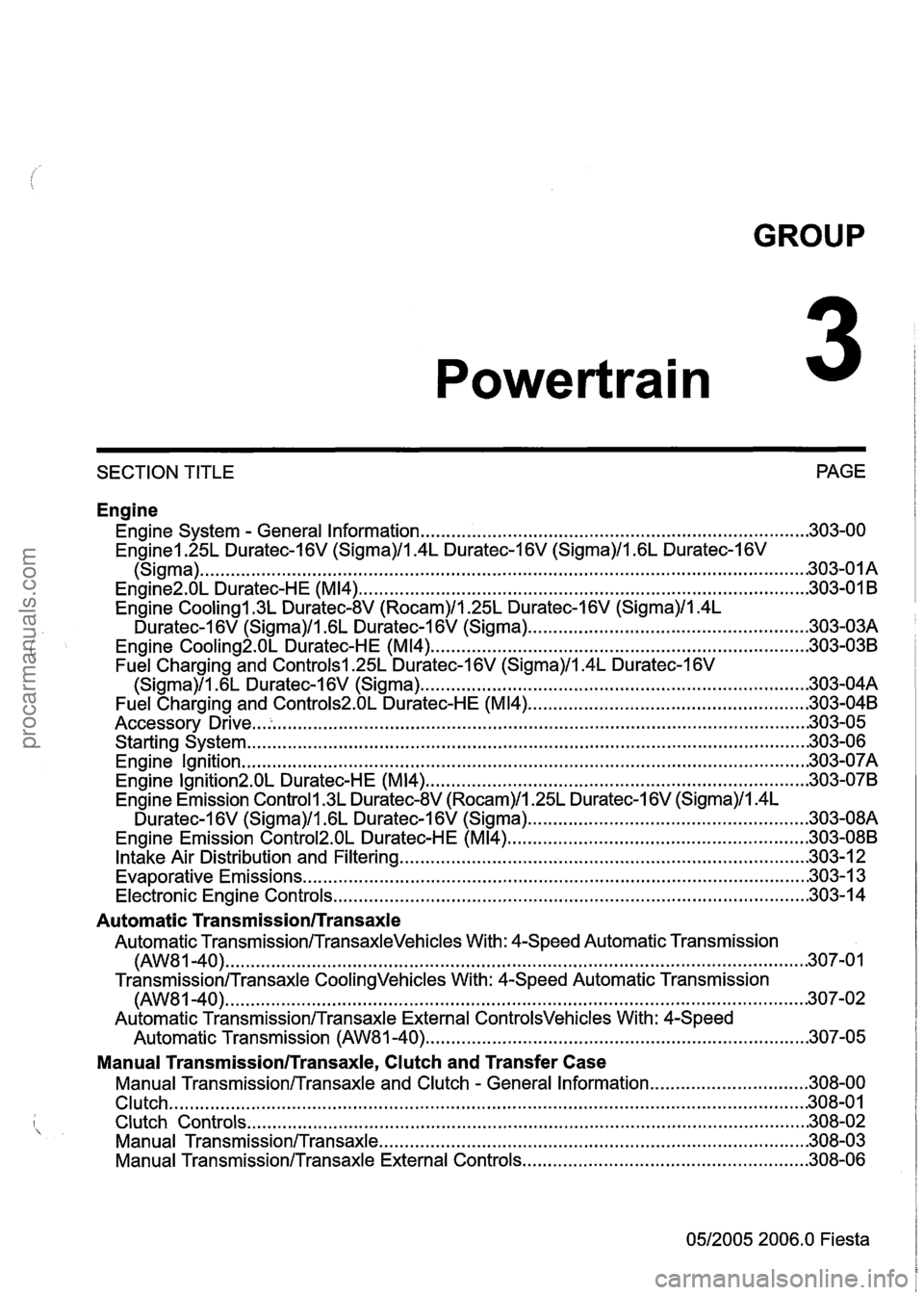
GROUP
Powertrain
SECTION TITLE PAGE
Engine
Engine System . General Information ........................................................................\
.... 303-00
Enginel.25L Duratec-I 6V (Sigma)ll.4L Duratec-1 6V (Sigma)ll . 6L Duratec-I 6V
........................................................................\
.............................................. (Sigma) -303-0 I A
........................................................................\
............... Engine2.0L Duratec-HE (M14) .30 3-01 B
Engine
Cooling1.3L Duratec-8V (Rocam)ll.25L Duratec-I 6V (Sigma)ll.4L
Duratec-1 6V (Sigma)ll . 6L Duratec-1 6V (Sigma) ...................................................... .30 3-03A
Engine
Cooling2.0L Duratec-HE (M14) ........................................................................\
.. 303-038
Fuel Charging and Controlsl.25L Duratec-1 6V (Sigma)ll.4L Duratec-1 6V
........................................................................\
... (Sigma)ll . 6L Duratec-1 6V (Sigma) .30 3-0414
Fuel Charging
and Controls2.0L Duratec-HE (M14) ....................................................... 303-04B
........................................................................\
.................................... Accessory Drive .30 3-05
Starting System
........................................................................\
...................................... 303-06
Engine Ignition
........................................................................\
....................................... 303-07A
Engine Ignition2.01 Duratec-HE (M14) ........................................................................\
... 303-07B
Engine Emission
Controll.3L Duratec-8V (Rocam)ll.25L Duratec-1 6V (Sigma)ll.4L
Duratec-1 6V (Sigma)ll . 6L Duratec-1 6V (Sigma) ...................................................... .30 3-08A
Engine Emission
Control2.0L Duratec-HE (M14) ........................................................... 303-088
........................................................................\
........ Intake Air Distribution and Filtering 303-1 2
........................................................................\
.......................... Evaporative
Emissions .30 3-13
........................................................................\
.................... Electronic Engine Controls .304 3-1
Automatic Transmission/Transaxle
Automatic Transmission/TransaxleVehicles With: 4-Speed Automatic Transmission
........................................................................\
......................................... (AW8 1 .40) .301 7.0
Transmission/Transaxle CoolingVehicles With: 4-Speed Automatic Transmission
........................................................................\
.......................................... (AW81-40) 307-02
Automatic
TransmissionlTransaxle External ControlsVehicles With: 4-Speed
........................................................................\
.. Automatic Transmission (AW81-40) .30 7.05
Manual Transmission/Transaxle. Clutch and Transfer Case
Manual Transmission/Transaxle and Clutch . General Information ............................... 308-00
........................................................................\
.................................................... Clutch .301 8.0
........................................................................\
..................................... Clutch Controls .30 8.02
Manual
TransmissionlTransaxle ........................................................................\
............ 308-03
Manual
TransmissionlTransaxle External Controls ........................................................ 308-06
0512005 2006.0 Fiesta
procarmanuals.com
Page 17 of 1226
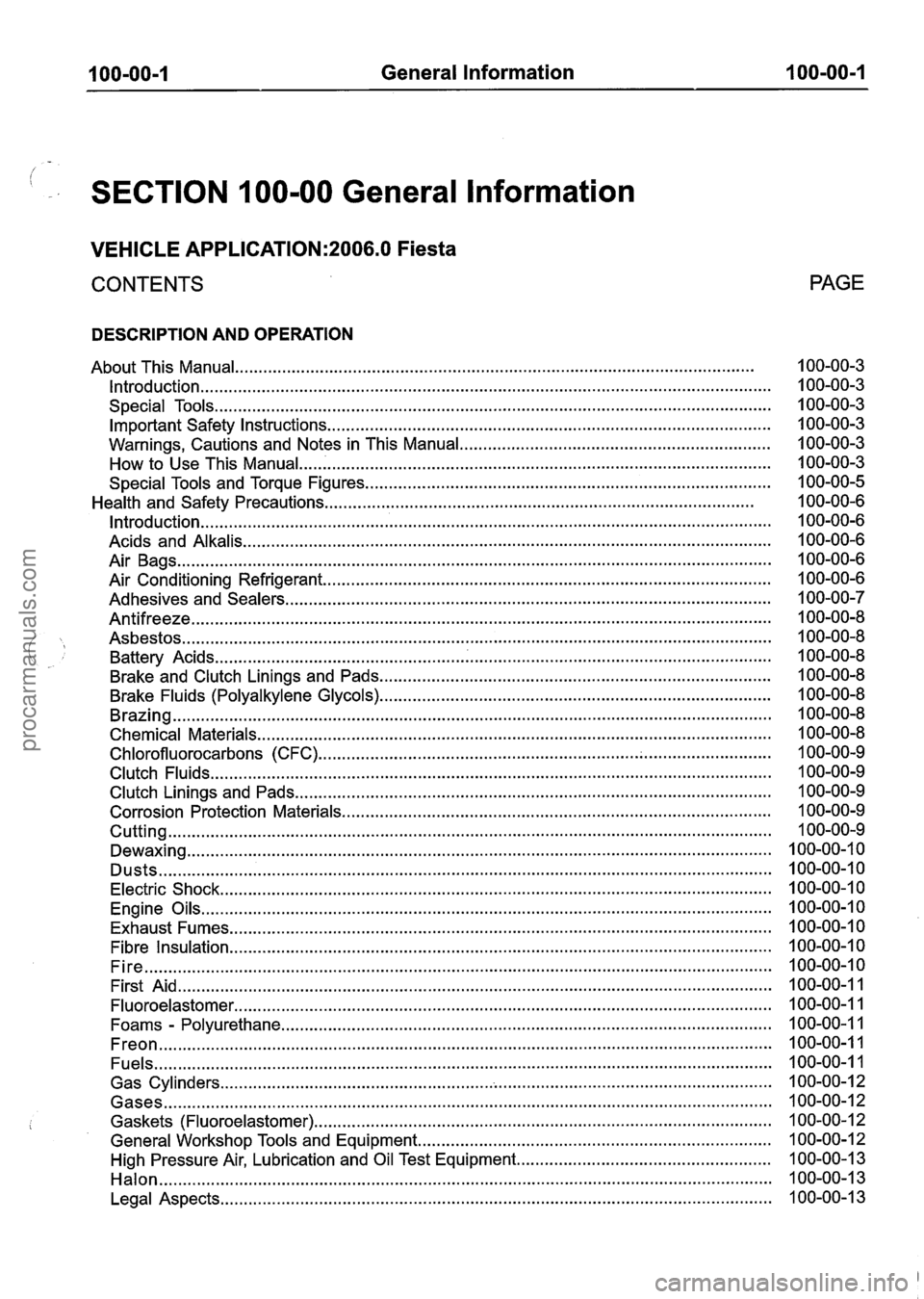
100-00-1 General Information 100-00-1
. SECTION 100-00 General lnformation
VEHICLE APPLICATION:2006.0 Fiesta
CONTENTS
DESCRIPTION AND OPERATION
About This Manual
........................................................................\
......................................
........................................................................\
................................................. Introduction
Special Tools
........................................................................\
..............................................
Important Safety Instructions ........................................................................\
......................
Warnings. Cautions and Notes in This Manual ..................................................................
How to Use This Manual ........................................................................\
............................
Special Tools and Torque Figures ........................................................................\
..............
Health and Safety Precautions ........................................................................\
...................
........................................................................\
................................................. Introduction
........................................................................\
........................................ Acids and Alkalis
Air Bags
........................................................................\
......................................................
Air Conditioning Refrigerant ........................................................................\
.......................
........................................................................\
............................... Adhesives and Sealers
........................................................................\
................................................... Antifreeze
........................................................................\
..................................................... Asbestos
Battery Acids
........................................................................\
..............................................
Brake and Clutch Linings and Pads ........................................................................\
...........
Brake Fluids (Polyalkylene Glycols) ........................................................................\
...........
........................................................................\
....................................................... Brazing
Chemical Materials
........................................................................\
.....................................
................................................................... Chlorofluorocarbons (CFC) ... ..........................
Clutch Fluids ........................................................................\
...............................................
Clutch Linings and Pads ........................................................................\
.............................
Corrosion Protection Materials ........................................................................\
...................
........................................................................\
........................................................ Cutting
........................................................................\
.................................................... Dewaxing
........................................................................\
.......................................................... Dusts
Electric Shock
........................................................................\
.............................................
Engine Oils ........................................................................\
.................................................
Exhaust Fumes ........................................................................\
...........................................
........................................................................\
........................................... Fibre Insulation
Fire
........................................................................\
.............................................................
First Aid ........................................................................\
......................................................
........................................................................\
.......................................... Fluoroelastomer
Foams
. Polyurethane ........................................................................\
................................
........................................................................\
.......................................................... Freon
........................................................................\
........................................................... Fuels
........................................................................\
.............................................. Gas Cylinders
........................................................................\
......................................................... Gases
Gaskets (Fluoroelastomer)
........................................................................\
.........................
General Workshop Tools and Equipment ........................................................................\
...
High Pressure Air. Lubrication and Oil Test Equipment ......................................................
........................................................................\
.......................................................... Halon
........................................................................\
............................................. Legal Aspects
PAGE
procarmanuals.com
Page 18 of 1226
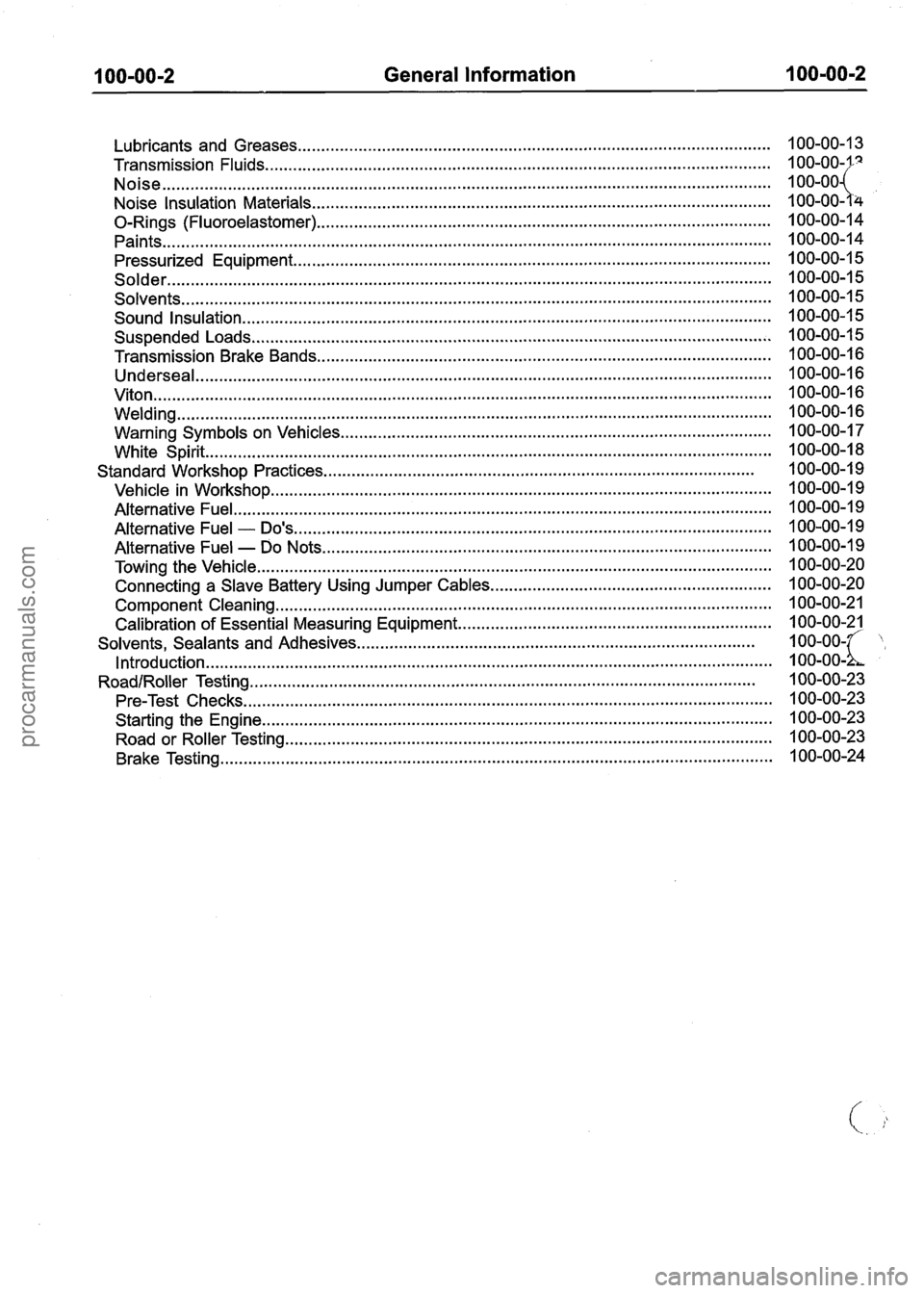
General Information
........................................................................\
............................. Lubricants and Greases
Transmission Fluids
........................................................................\
....................................
........................................................................\
.......................................................... Noise
Noise Insulation Materials
........................................................................\
..........................
0-Rings (Fluoroelastomer) ........................................................................\
.........................
........................................................................\
.......................................................... Paints
........................................................................\
.............................. Pressurized Equipment . . ........................................................................\
......................................................... Solder
........................................................................\
...................................................... Solvents
Sound Insulation
........................................................................\
.........................................
Suspended Loads ........................................................................\
.......................................
Transmission Brake Bands ........................................................................\
.........................
........................................................................\
................................................... Underseal
........................................................................\
............................................................ Viton
........................................................................\
....................................................... Welding
........................................................................\
.................... Warning Symbols on Vehicles
........................................................................\
................................................. White Spirit
Standard Workshop Practices
........................................................................\
....................
Vehicle in Workshop ........................................................................\
...................................
Alternative Fuel ........................................................................\
...........................................
Alternative Fuel - Do's ........................................................................\
..............................
Alternative Fuel - Do Nots ........................................................................\
........................
Towing the Vehicle ........................................................................\
......................................
Connecting a Slave Battery Using Jumper Cables ............................................................
Component Cleaning ........................................................................\
..................................
Calibration of Essential Measuring Equipment ...................................................................
Solvents. Sealants and Adhesives ........................................................................\
.............
........................................................................\
................................................. Introduction
RoadlRoller Testing ........................................................................\
....................................
Pre-Test Checks ........................................................................\
.........................................
Starting the Engine ........................................................................\
.....................................
Road or Roller Testing ........................................................................\
................................
Brake Testing ........................................................................\
..............................................
procarmanuals.com
Page 19 of 1226
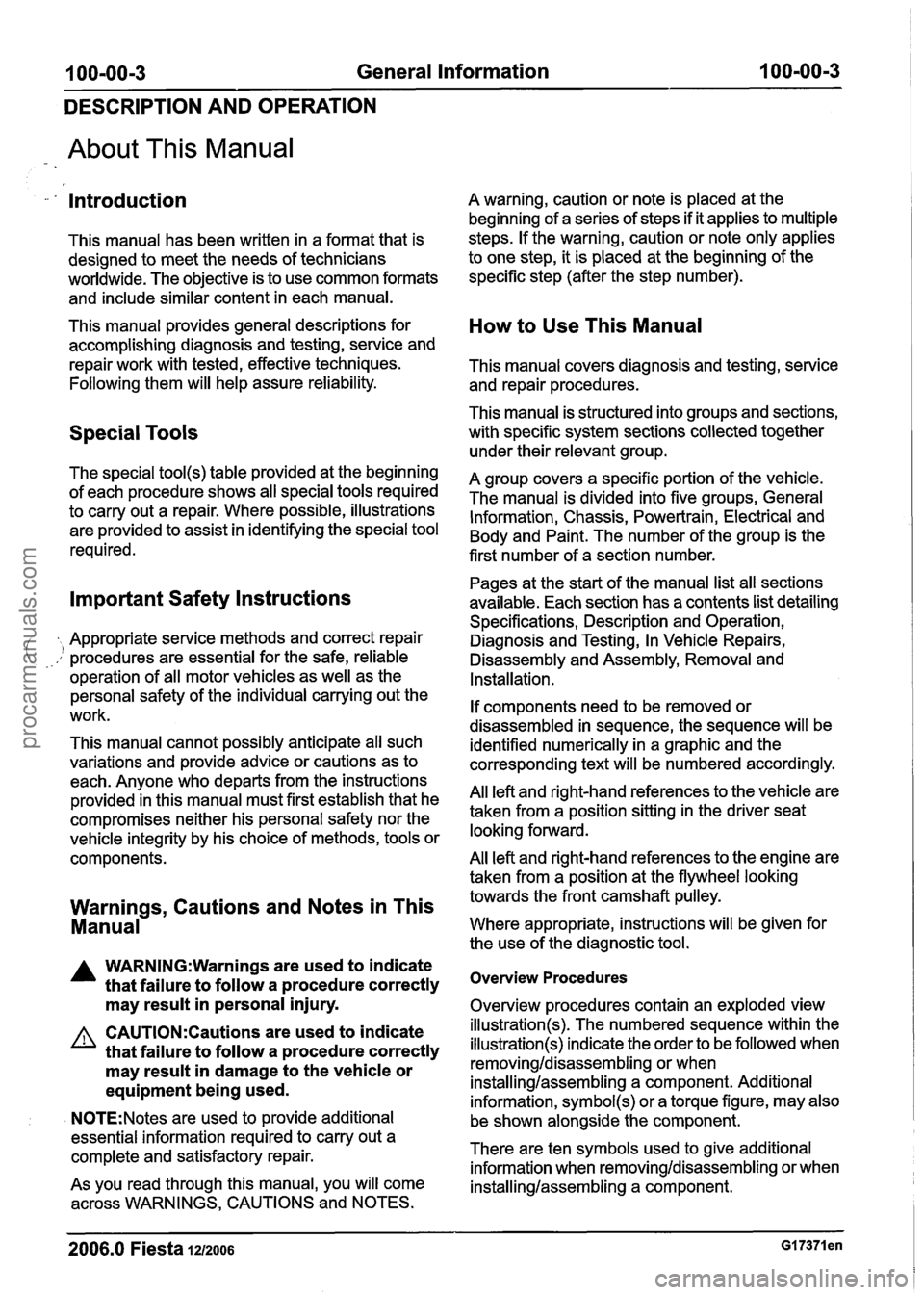
100-00-3 General Information 100-00-3
DESCRIPTION AND OPERATION
About This Manual
-- . Introduction
This manual has been written in a format that is
designed to meet the needs of technicians
worldwide. The objective is to use common formats
and include similar content in each manual.
This manual provides general descriptions for accomplishing diagnosis and testing, service and
repair work with tested, effective techniques.
Following them will help assure reliability.
Special Tools
The special tool(s) table provided at the beginning
of each procedure shows all special tools required
to carry out a repair. Where possible, illustrations
are provided to assist in identifying the special tool
required.
Important Safety Instructions
Appropriate service methods and correct repair
--.! procedures are essential for the safe, reliable
operation of all motor vehicles as well as the
personal safety of the individual carrying out the
work.
This manual cannot possibly anticipate all such
variations and provide advice or cautions as to
each. Anyone who departs from the instructions
provided in this manual must first establish that he
compromises neither his personal safety nor the
vehicle integrity by his choice of methods, tools or
components.
Warnings, Cautions and Notes in This
Manual
A WARN1NG:Warnings are used to indicate
that failure to follow a procedure correctly
may result in personal injury.
A warning, caution or note is placed at the
beginning of a series of steps if it applies to multiple
steps. If the warning, caution or note only applies
to one step, it is placed at the beginning of the
specific step (after the step number).
How to Use This Manual
This manual covers diagnosis and testing, service
and repair procedures.
This manual is structured into groups and sections,
with specific system sections collected together
under their relevant group.
A group covers a specific portion of the vehicle.
The manual is divided into five groups, General
Information, Chassis, Powertrain, Electrical and
Body and Paint. The number of the group is the
first number of a section number.
Pages at the start of the manual list all sections
available. Each section has a contents list detailing
Specifications, Description and Operation,
Diagnosis and Testing, In Vehicle Repairs,
Disassembly and Assembly, Removal and
Installation.
If components need to be removed or
disassembled in sequence, the sequence will be
identified numerically in a graphic and the
corresponding text will be numbered accordingly.
All left and right-hand references to the vehicle are
taken from a position sitting in the driver seat
looking forward.
All left and right-hand references to the engine are
taken from a position at the flywheel looking
towards the front camshaft pulley.
Where appropriate, instructions will be given for
the use of the diagnostic tool.
Overview Procedures
Overview procedures contain an exploded view
A CAUTI0N:Cautions are used to indicate illustration(s). The numbered sequence within the
that failure to follow a procedure correctly illustration(s) indicate the order to be followed when
may result in damage to the vehicle or removingldisassem bling or when
equipment being used. installinglassembling a component. Additional
information,
symbol(s) or a torque figure, may also
, , N0TE:Notes are used to provide additional
be shown alonaside the com~onent.
essential information required to carry out a
complete and satisfactory repair. There are
ten symbols used to give additional
information when
removina/disassemblincr or when V AS YOU read through this manual, YOU will come /"itallinglassembling a c&ponent.
across WARNINGS, CAUTIONS and NOTES.
2006.0 Fiesta 1212006 GI 7371 en
procarmanuals.com
Page 26 of 1226
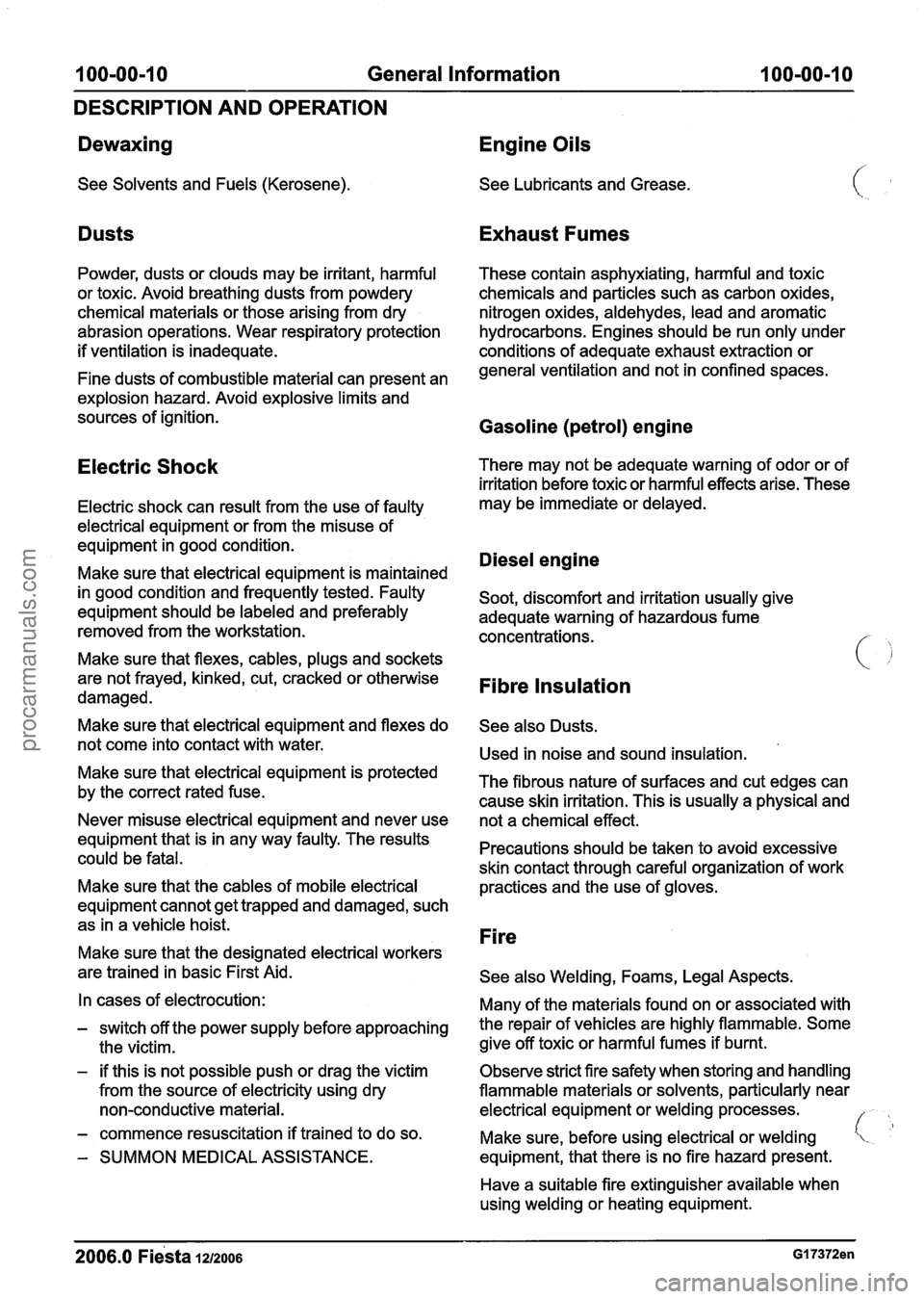
1 OO=OO-10 General Information 100-00-1 0
DESCRIPTION AND OPERATION
Dewaxing Engine Oils
See Solvents and Fuels (Kerosene). See Lubricants and Grease.
Dusts Exhaust Fumes
Powder, dusts or clouds may be irritant, harmful These contain asphyxiating, harmful and toxic
or toxic. Avoid breathing dusts from powdery chemicals and particles such as carbon oxides,
chemical materials or those arising from dry nitrogen oxides, aldehydes, lead and aromatic
abrasion operations. Wear respiratory protection hydrocarbons. Engines should be run only under
if ventilation is inadequate. conditions of adequate exhaust extraction or
Fine dusts of combustible material can present an general ventilation
and not in confined spaces.
explosion hazard. Avoid explosive limits and
sources of ignition.
Gasoline (petrol) engine
Electric Shock There may not be adequate warning of odor or of
irritation before toxic or harmful effects arise. These
Electric shock can result from the use of faulty may be immediate
or delayed.
electrical equipment or from the misuse of
equipment in good condition.
Diesel engine Make sure that electrical equipment is maintained
in good condition and frequently tested. Faulty
Soot, discomfort and irritation usually give
equipment should be labeled and preferably
adequate warning of hazardous fume
removed from the workstation. concentrations.
Make sure that flexes, cables, plugs and sockets
are not frayed, kinked, cut, cracked or otherwise
Fibre damaged.
Make sure that electrical equipment and flexes do
See also Dusts.
not come into contact with water.
Used in noise and sound insulation.
Make sure that electrical is protected The fibrous nature of surfaces and cut edges can by the correct rated fuse.
cause skin irritation. This is usually a physical and
Never misuse electrical equipment and never use
not a chemical effect.
equipment that is in any way faulty. The results
could be fatal. Precautions should
be taken to avoid excessive
skin contact through careful organization of work
Make sure that the cables of mobile electrical
practices and the
;se of gloves.
equipment cannot get trapped and damaged, such
as in a vehicle hoist.
-. Fire Make sure that the designated electrical workers
are trained in basic First Aid.
See also Welding, Foams, Legal Aspects.
In cases of electrocution:
Many of the materials found on or associated with
- switch off the power supply before approaching the repair of vehicles are highly flammable. Some
the victim. give
off toxic or harmful fumes if burnt.
- if this is not possible push or drag the victim
Observe strict fire safety when storing and handling
from the source of electricity using dry flammable materials
or solvents, particularly near
non-conductive material. electrical equipment or welding processes.
/
- commence resuscitation if trained to do so.
Make sure, before using electrical or welding 'L '
- SUMMON MEDICAL ASSISTANCE. equipment,
that there is no fire hazard present.
Have a suitable fire extinguisher available when
using welding or heating equipment.
procarmanuals.com
Page 30 of 1226
![FORD FIESTA 2007 Workshop Manual
100-00-1 4 General Information 100-00-1 4
DESCRIPTION AND OPERATION
Marigold Industrial (Blue Nitrile range)]. If gloves
become torn or contaminated on the inside they
should be replaced. Eye FORD FIESTA 2007 Workshop Manual
100-00-1 4 General Information 100-00-1 4
DESCRIPTION AND OPERATION
Marigold Industrial (Blue Nitrile range)]. If gloves
become torn or contaminated on the inside they
should be replaced. Eye](/img/11/56936/w960_56936-29.png)
100-00-1 4 General Information 100-00-1 4
DESCRIPTION AND OPERATION
Marigold Industrial (Blue Nitrile range)]. If gloves
become torn or contaminated on the inside they
should be replaced. Eye protection with safety
glasses is appropriate. Use of an impervious apron
and arm protectors may be necessary if more
extensive exposure is possible. Use of skin barrier
creams suitable for work with mineral oil products
may offer some supplementary protection, but such
barrier creams should not be used in place of
protective clothing.
If accidental skin contact occurs with the fluids,
wash the area thoroughly with soap or skin
cleanser and water.
Accidental eye contact should be dealt with as per
normal first aid practices, by flushing the eyes with
an eye wash or clean cool water for
10 minutes,
after which medical attention should be obtained.
Remove and launder clothing which becomes
contaminated with the fluids. Do not place rags
contaminated with fluid in clothing pockets.
Wash thoroughly
after completing operations where
skin exposure may have occurred.
It is important that personnel do not smoke, eat or
drink whilst handling the fluids or affected
transmissions. These measures are designed to
limit the risk from accidental ingestion.
Label any decanted fluid
properlyluse an equivalent
label to that on original product containers.
Clean up any spills promptly using an inert
absorbent and wash down contaminated surfaces
with detergent and water.
Dispose of any waste fluids safely as hazardous
waste. Do
not employ used engine oils as lubricants or
for any application where appreciable skin contact
is likely to occur.
Environmental Precautions
Burning used engine oil in small space heaters or
boilers can be recommended only for units of
.
approved design. If in doubt check with the
appropriate local authority and manufacturer of
approved appliances.
Dispose of used oil and used oil filters through
authorized waste disposal contractors or licensed
waste disposal sites, or to the waste oil reclamation
trade. If in doubt, contact the relevant local
authority for advice on disposal facilities.
It is illegal to pour used oil on to the ground, down
sewers or drains, or into watercourses.
Noise
Some operations may produce high noise levels,
which could, in time, damage hearing. In these
cases, suitable ear protection must be worn.
Noise Insulation Materials
See Foams, Fibre Insulation.
0-Rings (Fluoroelastomer)
See Viton.
Paints
Safety Data Sheets
See also Solvents, Chemical Materials.
Safety Data Sheets, which detail specific material handling instructions and precautions are available
from the respective national sales company, and
via internet
www.msds.ford .corn.
Used Engine Oil
Prolonged and repeated contact with mineral oil
will result in the removal of natural fats from the
skin, leading to dryness, irritation and dermatitis.
In addition, used engine oil contains potentially
harmful contaminants, which may cause skin
cancer. Adequate means of skin protection and
washing facilities must be provided. Highly flammable, flammable
- observe No
Smoking policy
One Pack
Can contain harmful or toxic pigments, driers and
other components as well as solvents. Spraying
should be carried out only with adequate
ventilation.
2006.0 Fiesta 1212006 GI 7372en
procarmanuals.com
Page 31 of 1226

General Information
DESCRIPTION AND OPERATION
Two Pack
Can also contain harmful and toxic unreacted
resins and resin hardening agents. The
manufacturers instructions should be followed. See
also Resin-based Adhesives and
Isocyanate
Adhesives and Sealers under Adhesives and
Sealers.
Spraying should preferably be carried out in
exhausted ventilated booths removing vapor and
spray mists from the breathing zone. Individuals
working in booths should wear appropriate
respiratory protection. Those doing small-scale
repair work in the open workshop should wear
air-fed respirators.
Pressurized Equipment
See High Pressure Air, Lubrication and Oil Test
Equipment.
Solder
Solders are mixtures of metals such that the
melting point of the mixture is below that of the
constituent metals (normally lead and tin). Solder
application does not normally give rise to toxic lead
fumes, provided a
gaslair flame is used.
Oxy-acetylene flames should not be used, as they
are much hotter and will cause lead fumes to be
produced.
Some fumes may be produced by the application
of any flame to surfaces coated with grease, and
inhalation of these should be avoided.
Removal of excess solder should be undertaken
with care, to make sure that fine lead dust is not
produced, which can give toxic effects if inhaled.
Respiratory protection may be necessary.
Solder spillage and filings should be collected and
removed promptly to prevent general air
contamination by lead.
High standards of personal hygiene are necessary
in order to avoid ingestion of lead or inhalation of
solder dust from clothing.
Solvents
See also Chemical Materials, Fuels (Kerosene),
Fire.
For example acetone, white spirit, toluene, xylene,
trichloroethane.
2006.0 Fiesta 1212006
Used in cleaning and dewaxing materials, paints,
plastics, resins and thinners.
Some may be highly flammable or flammable.
Skin contact will degrease the skin and may result
in irritation and dermatitis following repeated or
prolonged contact. Some can be absorbed through
the skin in toxic or harmful quantities.
Splashes in the eye may cause severe irritation
and could lead to loss of vision.
Brief exposure of high concentrations of vapors or
mists will cause eye and throat irritation,
drowsiness, dizziness, headaches and, in the worst
circumstances, unconsciousness.
Repeated or prolonged exposure to excessive but
lower concentrations of vapors or mists, for which
there might not be adequate warning indications,
can cause more serious toxic or harmful effects.
Aspiration into the lungs, for example through
vomiting, is the most serious consequence of
swallowing.
Avoid splashes to the skin, eyes and clothing. Wear
protective gloves, goggles and clothing if
necessary.
Make sure there is good ventilation when in use,
avoid breathing fumes, vapors and spray mists and
keep containers tightly sealed. Do not use in
confined spaces.
When spraying materials containing solvents, for
example paints, adhesive, coatings, use extraction
ventilation or personal respiratory protection in the
absence of adequate general ventilation.
Do not apply heat or flame except under specific
and detailed manufacturers instructions.
Sound Insulation
See Fibre Insulation, Foams.
Suspended Loads
A CAUTI0N:Never improvise lifting tackle.
There is always a danger when loads are lifted or
suspended. Never work under an unsupported,
suspended or raised load, for example a
suspended engine.
Always make sure that lifting equipment such as
jacks, hoists, axle stands and slings are adequate
and suitable for the job, in good condition and
regularly maintained.
procarmanuals.com
Page 33 of 1226
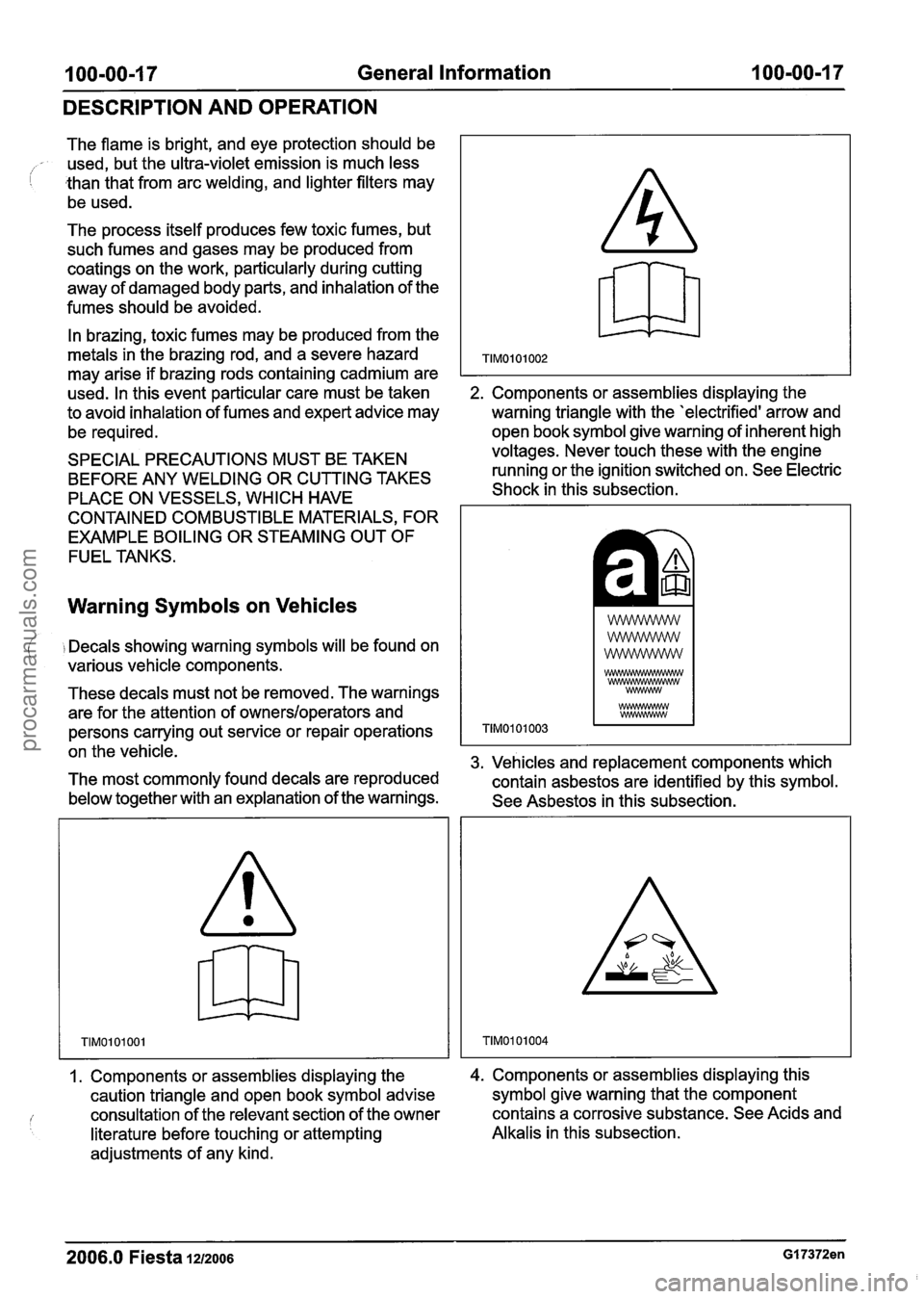
100-00-1 7 General Information 100-00-1 7
DESCRIPTION AND OPERATION
The flame is bright, and eye protection should be - used, but the ultra-violet emission is much less
than that from arc welding, and lighter filters may
be used.
The process itself produces few toxic fumes, but
such fumes and gases may be produced from
coatings on the work, particularly during cutting
away of damaged body parts, and inhalation of the
fumes should be avoided.
In brazing, toxic fumes may be produced from the
metals in the brazing rod, and a severe hazard
may arise if brazing rods containing cadmium are
used. In this event particular care must be taken
2. Components or assemblies displaying the
to avoid inhalation of fumes and expert advice may
warning triangle with the 'electrified' arrow and
be required. open book symbol
give warning of inherent high
SPECIAL PRECAUTIONS MUST BE TAKEN voltages.
Never touch these with the engine
BEFORE ANY WELDING OR CUTTING TAKES running
or the ignition switched on. See Electric
PLACE ON VESSELS, WHICH HAVE Shock
in this subsection.
CONTAINED COMBUSTIBLE MATERIALS, FOR
EXAMPLE BOILING OR STEAMING OUT OF
FUEL TANKS.
Warning Symbols on Vehicles
( i Decals showing warning symbols will be found on
various vehicle components.
These decals must not be removed. The warnings
are for the attention of
owners/operators and
persons carrying out service or repair operations
on the vehicle.
3. Vehicles and replacement components which
The most commonly found decals are reproduced
contain asbestos are identified by this symbol.
below together with an explanation of the warnings.
See Asbestos in this subsection.
1. Components or assemblies displaying the
caution triangle and open book symbol advise
consultation of the relevant section of the owner
literature before touching or attempting
adjustments of any kind. 4. Components or assemblies displaying this
symbol give warning that the component
contains a corrosive substance. See Acids and
Alkalis in this subsection.
2006.0 Fiesta 1212006 GI 7372en
procarmanuals.com